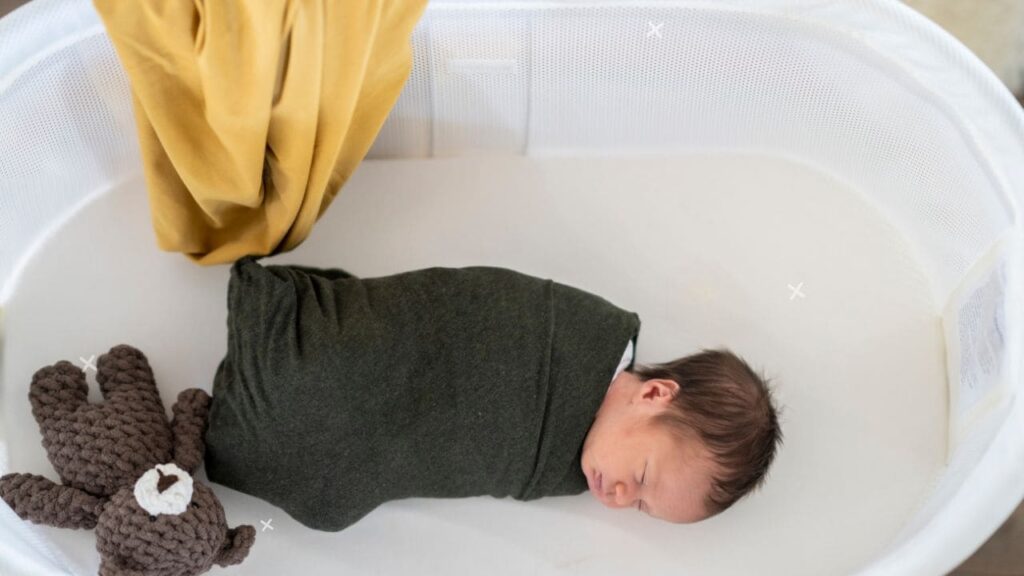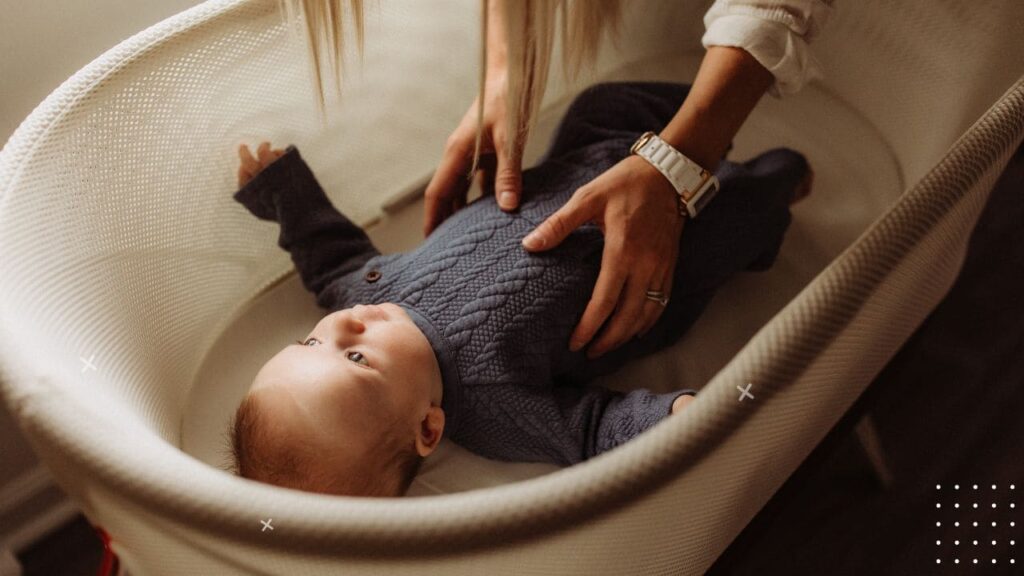As an excited but exhausted new parent, I remember gazing longingly at my son’s beautiful bassinet, wishing he would snooze soundly in the lovely nursery I had worked so hard to prepare. But often as soon as I lowered my warm, snuggly newborn into the cold, rigid bassinet, his eyes would pop wide open and he would unleash a desperate “help me” type wail. Not what this mama was hoping for during those hazy midnight feeding sessions!
If this scenario sounds familiar, don’t worry – you and your baby are totally normal. Many newborns strongly resist snoozing solo in the big, open bassinet right away. But never fear, through lots of trial and tribulation, I discovered several tricks that can encourage even the most stubborn infants to slumber peacefully in their bed. Read on for 7 amazing hacks to finally get your little one sleeping in their bassinet!

Why Your Darling Newborn Refuses Bassinet Sleep
Before diving into solutions, understanding why your newborn rebuffs the bassinet can help inform tricks that will work. Here are the most common reasons these tiny dictators protest our grand nursery plans:
Preference for Closeness
Fresh out of the womb, infants feel safest and most secure nestled skin-to-skin against mom or dad’s comforting warmth. The shock of transitioning to a cold, rock-hard mattress alone often offends their sensibilities. Rude awakening indeed!
Unfamiliar Motion
The gentle swaying, rocking, twisting movements of mom shuffling about her day soothed baby throughout pregnancy. But the stiff stillness of a stationary bassinet lacks that familiar motion they love.
Sensitivity to Noise Level
Inside the womb, a white noise symphony of gentle gurgling and swooshing enveloped your wee one. So the sudden silence or echoes of a quiet nursery are very alarming.
Confusion With Day vs Night Cycles
Newborns often resist defined sleep stretches until around 2 months old. So enforcing strict “bedtime” right away frustrates many babies. Instead, capitalizing on natural sleepy periods is key in the first month or two.
Startle Reflex Triggers
Until about 4 months old, infants reflexively throw out their arms, stretch their legs, then pull them back in when startled. So new sounds, light changes, and moving through the air onto a surface can all set off this reaction and foil your perfect bassinet transfer!
As you likely suspected from late-night pacing sessions while Googling “newborn won’t sleep in bassinet”, no magical fairy resolves every sleep struggle overnight (wouldn’t that be nice though!). But several science-backed tricks can coax even the stubbornest babe into blissful solo bassinet slumber.

Tailoring Techniques to Your Unique Newborn
As any frazzled parent knows, every sweet little tyke has their own style, preferences, and ideas for proper sleep habits. Comparing your fussy Francis to your neighbor’s distinctly drowsy Darla will only drive you bonkers. Instead, scrutinize your unique baby’s specific sleep behaviors to crack their personal bassinet avoidance code:
When Does She Get Drowsy?
Track sleep windows throughout the day so you can seize perfect transfer timing later.
Where Does He Snooze Deepest?
Identify your champion baby soothing spot to recreate factors elsewhere.
What Noises/Lighting Help Her Chill?
Note lighting levels, white noise tracks, etc. that have sedative effects.
Unraveling the mysteries of your mini-me’s slumber sweet spots allows customizing a tailored translator plan from a comfy sleep location to a clean bassinet without tears or trauma. Now that’s more!
Loving Bassinet Modifications For Fussy Babes
Once you pinpoint exactly what ambiance your newborn needs to drift off, recreate those soothing elements in the bassinet for smooth segueing between snuggle zones. Here are some common newborn preferences to consider:
Swaddle Wrapping
The tight coziness of swaddle wrapping recalls the snug womb walls while preventing embarrassing startle reflex wake-ups.
Warmth
Chilly newborns protest heartily. Try a heating pad (removed before laying baby down) or a warm water bottle to take the nip out of the air.
White Noise
Whether shush machines, vacuums, showers, or hair dryers, amplify womb-like white noise to mute disruptive household sounds.
Motion
Gently rocking the bassinet or stroller with your hand reassures the baby their movement needs are met.
Side-Sleep Positioners (Consult Pediatrician First!)
Allows reflux-prone babies to sleep at an incline without dangerous pillow props.
| Goal | Method | Tools |
|---|---|---|
| Block Light | Total blackout shades | Blackout curtains, shades, window film |
| Dampen Noise | Generate white noise | Sound machines, fans, apps |
| Ensure Safety | Back sleep, bare crib | Crib sheet only, no stuffed animals |
| Contain Startles | Snug swaddle | Sleep sacks, halo swaddles, muslin blankets |
| Radiate Warmth | Mattress heater | Electric mattress pads, hot water bottles |
Coaxing Your Wee One Into Solo Snoozing
While modifying the bassinet setup addresses physical discomforts, teaching your babe healthy self-soothing skills minimizes separation anxiety during those sinking into sleep moments. These tips encourage independence:
Allow “Power Down Time” After Feeding
Rather than jostling a milk-drunk, drowsy babe straight into bed, let them chill upright on your chest for 5-10 minutes while milk settles. This prevents stirring them up during the transfer.
Establish Soothing Bedtime Routines
Repeating the same pre-sleep rituals nightly like swaddling, white noise, abbreviated nursing, and loving lullabies signals sleepy time.
Introduce Pacifiers Early
Sucking soothes infants and pacifiers allow them to mimic the comfort of nursing or bottle feeding hands-free.
Make bassinet sleep training sessions gradual and rewarding to build confidence. With time your determined darling will transform into a champion solo snoozer!
Bassinet Sleep Partners: Co-Sleepers & Bedside Bassinets
If despite your most creative efforts your little nugget still clings to physical closeness for sleeping, devices allowing safe bed sharing or tandem bassinet snoozing smooth the transition toward independent slumber by still supplying contact comfort.
Bedside Bassinets
Attach snugly alongside your mattress with a portion wall removed for direct nighttime access to the baby.
Co-Sleeper Bassinet Attachments
Conveniently cradle your baby right beside your bed in an infant nest with protective barriers.
Wearable Baby Carriers
Allows babywearing for naps so they snooze blissfully snuggled while freeing up your hands.
While direct cuddling carries risks if safety precautions aren’t taken, these handy tools allow your babe’s craving for physical connection while ensuring their secured comfort.

Specific Bassinet Sleep Saboteurs By Age
In addition to the general newborn bassinet avoidance discussed so far, babies reach developmental milestones during the first 6 months that can further disrupt their slumber. Being aware of potential sleep plan hurdles at various ages helps overcome temporary backslides:
6 Weeks Old: Peak of Startle Reflex
Continue swaddling and white noise to prevent reaction triggers.
3-Month Growth Spurt: Increased Hunger
Add dream feeds to keep their bellies full for longer stretches.
4 Month Sleep Regression
Revert night feedings, rocking, and vocal reassurance to resettle.
Of course, every sweet child follows their own schedule, but understanding typical obstacles ages helps you interpret and address sudden sleep setbacks gently and effectively.
| Age | Common Sleep Disruptors | Solutions |
|---|---|---|
| 0-3 months | Hunger, startle reflex, preferring motion | Frequent feeding, tight swaddling, rocking |
| 3-6 months | 4 month sleep regression, separation anxiety | Consistency with training, transitional objects |
| 6-12 months | Sickness disrupting sleep, teething pain | Humidifiers, cold teethers |
Overcoming Common Night Waking Reasons
Even after getting your little darling accustomed to dozing blissfully in their bassinet, you will likely still encounter middle-of-the-night wake-ups demanding your attention. But having savvy troubleshooting tactics ready to tackle the top nighttime interruptions will have you all back to restful slumber in no time.
The first bleary-eyed priority is addressing physical distress to determine if the baby is waking out of genuine discomfort. Hunger, diaper leaks, sickness, and other disruptors should be remedied first when possible. Then implement additional soothing methods for falling back asleep quickly. Here are the top night-waking culprits and solutions:
Hunger Hiccups
Between 2 and 5 months, growth spurts can increase nutritional demands and wake baby prematurely seeking feeds. Try adding a “dream feed” right before parents’ bedtime around 10 PM to fuel up their belly longer. Starting solids between 4 and 6 months also supports sustaining them overnight.
*Blowout Whoopsies
The loose diaper fits and impaired absorbency from cheap brands often end in disastrous diaper leaks. Try more snug swaddling, sizing up in diapers at night, or using overnight-specific formulations to contain messes until morning.
Stuffy Noses and Chest Congestion
Especially during winter months, mucus build-up from colds disrupts unobstructed airflow making rest impossible. Try elevating the baby’s crib mattress, using pediatrician-approved saline sprays before bed, or running a humidifier to ease stuffiness so everyone gets more zzz.
Separation Anxiety Appears
Around 4 or 5 months, babies grow more aware of parents as separate entities which provokes separation anxiety when left alone. Introduce transitional objects like blankets or toys with your scent and increase physical bonding time like babywearing before bed to prevent panicked waking.
Sleep Regressions Strike Back
Around 4 months, 8 months, and 18 months, babies mentally leap forward developmentally which causes temporary sleep setbacks due to overstimulation. Maintain consistency through the regression storm rather than attempting big sleep training changes during the disruption.
Next Step Advice: Quickly check for dirty diapers or hunger cues as the first response when baby fusses at night. Offer a small feed if needed, singing comforting lullabies whilst nursing to prevent overstimulation. Avoid turning lights on or engaging in stimulating play if the baby wakes fully. Instead employ gentle patting, pacifiers, and loving reassurance to drift back to dreamland.
Consistency conquers these pesky nighttime pitfalls! Stay attentive yet dull when addressing needs to teach self-soothing skills parallel to addressing disruptors.

Red Flag Reasons For Bassinet Avoidance
While most infant bassinet boycotting relates to normal adjustment challenges, certain medical conditions like reflux, allergies, or skeletal abnormalities also provoke discomfort that deters bedtime.
Contact Doctor If Baby:
- Frequently arches back, pulls legs inward
- Resists lying flat for any sleep
- Exhibits obvious signs of pain around sleep
- Vomits frequently or spits up excessively
Diagnosing and addressing underlying health issues minimizes agony and allows restful recovery. Consult your pediatrician sooner than later if your little love repeatedly displays distress around sleep time regardless of your stellar soothing efforts!
Encouraging Bassinet Acceptance From Day 1
Preventing hardcore bassinet refusal outright is ideal over backtracking to reteach this key sleep skill later. Try these proactive steps:
Practice Daily Bassinet Power-Naps
Work up to consistency through short, successful day sleep sessions first.
Make It Smell Like You
Rub your scent on the bassinet sheet so your smell comforts them.
Use Movement to Soothe
Try rocking motions to settle the baby instead of bouncing or jostling.
Swaddle Tightly
Prevent startles from throwing off their groove during the falling-asleep phase.
Employ White Noise
Drown out disruptive household sounds that foil the transition.
Think of going bassinet usage as a “sleep training light”. Rather than pushing extremes right away, set the baby up for positive associations through gentle, nurturing guidance. The more they accept daytime bassinet catnaps, the more the bassinet beckons blissfully at bedtime too!
Creating Positive Sleep Associations
In addition to resolving physical discomforts, establishing healthy associations between bedtime routines, the bassinet sleep space itself, and solo sleeping fosters self-soothing skills that prevent pesky midnight meltdowns. Here are proactive steps for encouraging positive sleep skills over negative sleep crutches:
Put Baby Down Drowsy But Awake
Rather than nursing or rocking them fully unconscious, set them down while still mildly alert. This teaches them to get comfy and doze without assistance.
Employ Transitional Objects
Introduce security blankets, special pacifiers, or cuddly stuffed toys for them to snuggle as they fall asleep. Avoid parental sleep crutches.
Establish Total Blackout Conditions
Ensure the nursery has total light blockage day and night so any illumination changes don’t trigger wake-ups.
Commit to Consistent Routines
Adhere to fixed schedules of bath time, pajamas, and stories then sing x amount of songs while rocking before setting baby down awake. Consistency has sedative effects.
Next Step Advice: Choose one element like lighting conditions to address first if the baby resists change. Add other routine adjustments gradually over days and weeks to build on successes slowly rather than expecting overnight cooperation. Celebrate small wins and give an appraisal for steps toward independence!
With nurturing dedication, newborns develop fabulous sleep skills allowing all-night peace minus desperate parental intervention. Stay consistent in gentle guidance and they’ll soon drift off merrily solo!
Persevering With Positive Reinforcement
Don’t abandon ship too quickly if your newborn bucks the bassinet system at first! Traumatic responses pressure parents to ditch the plan and default to rock n’ play sleeper props. But remaining determined through ups and downs pays off.
When bassinet mutinies arise try tag-teaming with your partner for refresher breaks. Revisiting the drawing board before desperation sets in keeps perspective balanced. Some babies teeter-totter longer before fully embracing solo sleep. But with consistent TLC, they all come around eventually!
In the thick of a sleep-deprived stupor, it’s easy to question your choices. But remember the bassinet promotes protecting your baby the safest way possible. So breathing deep and soldiering on pays double dividends for your family in both rest and well-being.
Celebrating Sleep Wins As They Come
Amid the fatigue of sleep training try to relish sweet milestones instead of bemoaning lingering limitations:
4 Hours In Bassinet = Major Win!
Even one longer bassinet stretch helps whole home happiness.
Only 1 Midnight Wake Up!
Cutting night demands in half restores sanity faster.
Napped 30 Minutes Alone!
Day sleeps translate to night sleep success.
Adjust expectations and define “success” as any slight improvement or step toward independence. Give yourself and your groggy little pumpkin pep talks and pats on the back to stay pumped up!
Getting Professional or Community Support
If after weeks of trying every trick suggested with minimal sleepy success, feelings of frustration and failure often simmer. But don’t abandon hope! Continuing the quest with professional sleep guidance or empathetic communities prevents parental burnout while unlocking customized solutions.
If medical issues are suspected, describe symptoms and struggles to the baby’s pediatrician for tailored treatment recommendations maximizing comfort. For sleep habit hurdles, consult certified sleep consultants or training coaches to formulate personalized sleep programs to ensure restful nights.
Finding solidarity among other parents enduring similarly sleepless periods helps too! Connect with support groups on Facebook, local community boards, or online forums seeking advice. Sometimes just venting fears and validating experiences with veterans of the infant sleep wars does wonders to lift spirits and regain determination.
Next Step Advice: Avoid comparisons and self-blame when progress feels stalled. Every infant follows unique timelines and challenges are not reflections of parental competency. Support others on tough days by sharing what ended up working for your little one!
With professional guidance plus community comfort, the path to peaceful nights gets illuminated much faster. So reach out when resolve wavers—help happens!
Wrapping Up With Hope
If your sluggish sleeper still shuns bassinet comfort despite multiple creative attempts to transform it into a sleepy time sanctuary, stay confident consistent kindness will win them over with time. Keep communicating with your pediatrician to tackle medical barriers impeding restfulness. And remember to extend compassion to yourself and your baby as you figure out personalized sleep solutions together.
The key is remaining responsive to your child’s unique needs while gently nudging them toward healthy habits that will serve them best overall. With teamwork and tenacity, your rest refusal period will transition into a distant memory. So take heart fellow parents, your efforts are not in vain. Pleasant dreams ahead!
FAQ – Newborn Won’t Sleep in Bassinet
How can I tell if my newborn’s bassinet avoidance is normal or something more concerning?
Most infants resist bassinets at first simply because they prefer snuggles and motion. But if baby displays frequent arching, crying that escalates when laid flat, excessive vomiting, or obvious signs of pain around sleep time, consult your pediatrician to rule out reflux, allergies, or other medical problems interfering with sleep.
What temperature should the bassinet be for optimal newborn sleep?
Room temperature between 68-72 degrees Fahrenheit is ideal. Use a thermometer and monitor the bassinet area itself. Run a warm water bottle or heating pad (removed before baby is placed) in the bassinet as needed to reach 70ish degrees.
How often should I try placing my 1 month old in the bassinet for daytime naps?
Practice makes perfect! Aim for at least 2-3 bassinet trial runs per day starting at 1 month old. Even short 10-15 minute catnaps help reinforce positive associations. Quickly rescue baby before excessive frustration sets in. Over time, durations will naturally increase.
My baby keeps startling herself awake as we transfer to the bassinet. What can prevent this reflex?
Startle reflex triggers until about 4 months old. Try putting baby to sleep in a SwaddleMe pod with secure but flexible arm wrap coverage. The gentle pressure soothes them while muting embarrassing reflex reactions during the falling asleep transition phase.
I’ve tried everything and my 3 month old still hates the bassinet! When should I be concerned?
First, breathe! It’s totally age appropriate for resistance through 6 months especially during major development leaps. Regressions pass with consistency. Significant concern doesn’t usually start until 9 months+ if all medical issues are ruled out and you’ve worked closely with your pediatrician and sleep consultants.
The key is tailoring solutions to your infant’s needs and relentlessly trying new techniques. With time, perseverance pays off. But no shame in asking for help!












